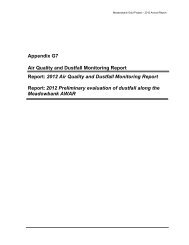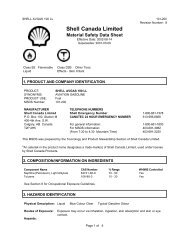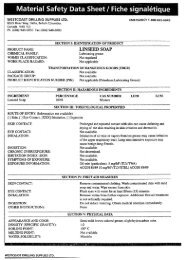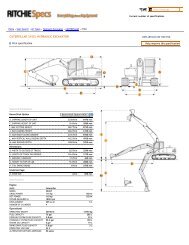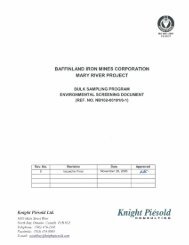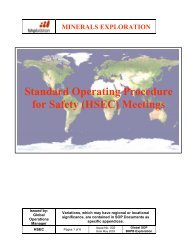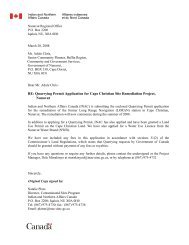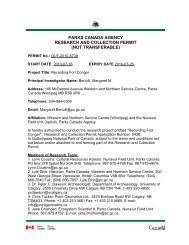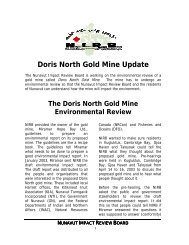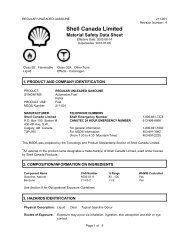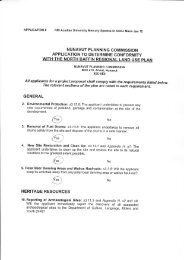080121-08MN006-Sabina Hackett River Project Proposal ... - NIRB
080121-08MN006-Sabina Hackett River Project Proposal ... - NIRB
080121-08MN006-Sabina Hackett River Project Proposal ... - NIRB
Create successful ePaper yourself
Turn your PDF publications into a flip-book with our unique Google optimized e-Paper software.
Description of the Existing Environment6.1.10.2 Bathymetry and LimnologyBathymetric surveys were conducted for 22 lakes during the summer of 2007 (Rescan 2008a).The lakes around the mine site area are small to medium sized lakes, with maximum depthsranging from 5.0 to 18.0 metres. Surface areas generally range from 47,000 m 2 to 840,000 m 2 ,and lake volumes generally range from 100,000 m 3 to 3,900,000 m 3 (Rescan 2008a). Theexception is Kerry Lake, which is very deep (maximum depth of 37.8 m). Larger lakes arepresent outside of the immediate project area.Winter physical limnological characteristics were measured in the lakes in May of 2007.Dissolved oxygen and temperature profiles were typical of ice-covered Arctic lakes. Watertemperatures were coldest at shallow depths just below the ice (0.5 to 1.5˚C), and graduallywarmed throughout the water column to maximum temperatures of around 3 to 4˚C near thewater/sediment interface. Dissolved oxygen concentrations were highest near the water/iceinterface (~10-12 mg/L), and gradually declined throughout the water column to minimumconcentrations near the water/sediment interface. The amount of natural oxygen depletion atdepth varied among lakes. Some lakes had bottom water dissolved oxygen concentrations of1 mg/L at depth, indicating that there was oxygen-consuming organic matter in sediments. Otherlakes maintained high levels of dissolved oxygen at depth (as high as 9 mg/L).Open-water season limnological characteristics were measured three times during 2007; in July,August, and September.Secchi depth, a measure of water clarity, varied from 4.2 to 12.2 m during the open-waterseason. Many lakes had clear enough water that the Secchi disk hit the bottom of the lake beforeit was no longer visible. The average Secchi depth for all lakes combined was lowest in July andhighest in September. This corresponds with average chlorophyll a concentrations being slightlyhigher in July compared to the other months.Secchi depth can be used to calculate the depth of the euphotic zone (the zone wherephotosynthesis can take place), and euphotic zone depths ranged from 11.4 to 33 m. Thisindicates that the majority of the water column for most lakes had enough light penetrating suchthat photosynthesis could take place in the entire water column.Dissolved oxygen and temperature profiles were typical of Arctic lakes during the open-waterseason. The lakes in the area mix fully at least two times per year; during ice breakup in thespring, and during high winds/low temperature conditions in the fall just prior to freeze up. Inaddition, the lakes are small enough around the <strong>Project</strong> area to become fully mixed during thesummer, depending on wind and temperature conditions. In 2007, thermal stratification wasevident in most lakes in July, with surface waters warming up to ~17 C (bottom temperaturesvaried among lakes; some lake bottom water was as cold as 5 C). Strong winds in early Augustcaused most lakes to be fully mixed, resulting in uniform temperature and dissolved oxygenvalues throughout the water column. Lakes were again fully mixed in September of 2007.Lakes remained well-oxygenated throughout the open-water season (~9-12 mg/L), with theexception of a few lower values just above the water/sediment interface.January 2008 <strong>Hackett</strong> <strong>River</strong> <strong>Project</strong> – <strong>Project</strong> <strong>Proposal</strong> <strong>Sabina</strong> Silver CorporationReport Version B.1 6–17 Rescan Environmental Services Ltd. (Proj. #833-2)



